In a past thread, someone commented about topologists not knowing the difference between a donut and a coffee cup.
I forwarded that to a friend of mine who’s a recovering topologist, who said “of course we can tell the difference: coffee stays in a cup and leaves a donut.”
When I was at one venture capitalists’ office, the lobby had a collection of artworks belonging to the founder, so that prospective companies can be impressed and awed by the multi-hundred-millionaire’s taste in toys. One headquarters had shelves covered with incredibly cool mathematical shapes, 3D printed in metallic steel. So I googled around to see if I could see who made them and post a link to them, here. It didn’t take me long to find the source, but in searching through the collection of items, I came across the answer to the donut/cup conundrum:
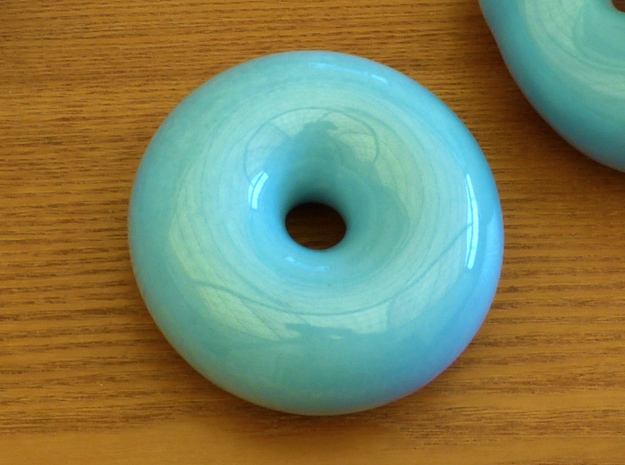
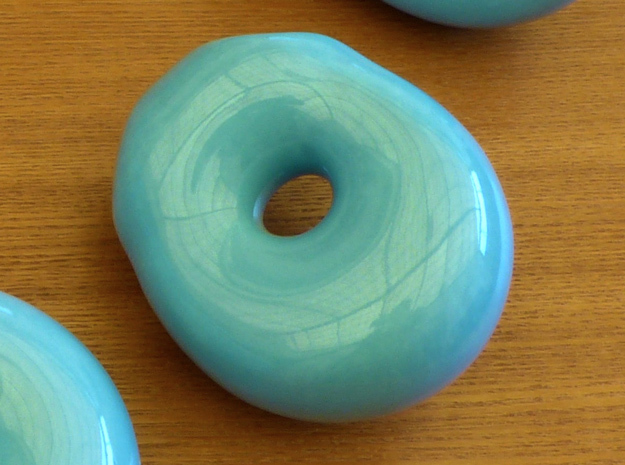
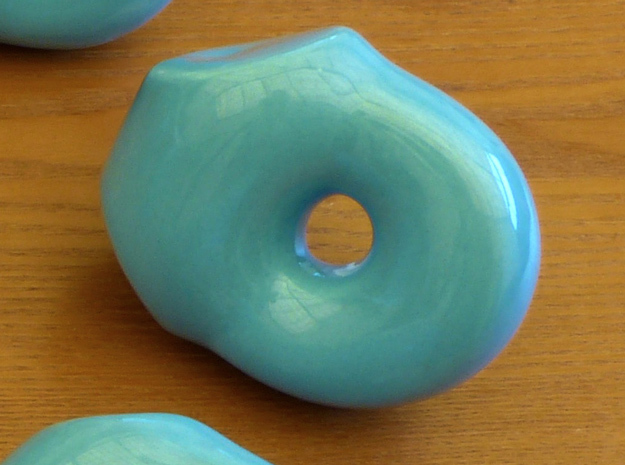
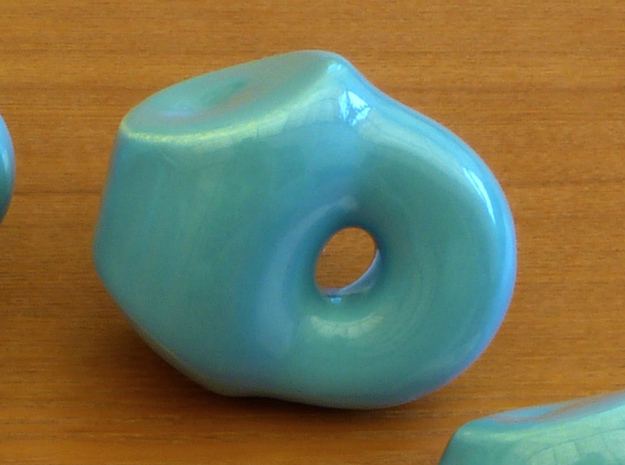
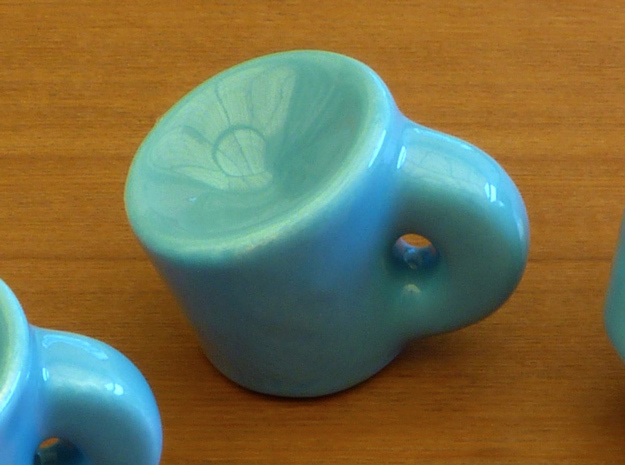
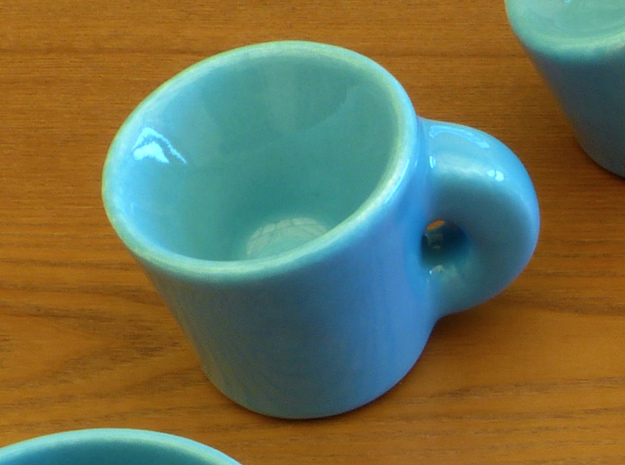


These were produced on Shapeways.com, from the gallery of Henry Segerman. The whole collection is worth a look. Some of the light shades are really cool.
When I was hanging out with investment bankers back in the late 90s, I spent a smallish amount of time in some big name brokerages and boardrooms. One of the things I noticed is that a lot of them are full of really amazing art. For example, I was a contractor installing an internet firewall back in 1995, at Cantor Fitzgerald in the World Trade Center in NYC, and was gobsmacked to find that the offices were a museum of bronzes by Rodin. I asked someone else about how that works, and they explained that some firms buy art to decorate the offices, then depreciate it on their books as a capital asset, and give it to the owner of the company so the owner can get it as a reduced-tax gift. I believe that particular tax dodge has been closed, but it was the “done thing” in the 90s. The Rodin sculptures were destroyed with the building. A variation of that tax dodge used to be used by high tech companies:
- buy a ferrari
- exhibit it at trade shows in your booth
- depreciate it off the books
- give it to the founder, now that it’s not “worth anything” anymore
I believe that the loophole is closed, because I don’t see as many exotic cars at tech show booths. If you google around, you can find small business examples of how you can depreciate an expensive SUV to avoid paying taxes. Same trick, just smalltime. According to this, artworks don’t depreciate like a sports car, but I bet the rush of sports cars in trade shows tracked the IRS’ clarification on artworks, and the rich are on to some other scam now that car depreciation is tied to bluebook value.

That’s cool. I never really got the joke, I always visualized some sort of Moebius belt wrapping around in 2D. Not sure why, probably failure imagination on my part.
As opposed to plastic steel?
Brian English@#1:
As opposed to plastic steel?
Presumably as opposed to coated plastic. It’s pretty typical to bind sintered metals in epoxy resin, to produce things that look and feel metallic, but aren’t really metal. I’m not sure what process the 3D printers use, materials-wise.
I had a fascinating conversation a few years ago with a guy who did powdered metal investment castings. Apparently you can get crazy precision without machining, by making a mold, filling it with powdered metals and heating it just the right amount – presto – solid metal object!
It’s just odd to me. Steel is mostly metal – iron, with a bit of carbon.
I 3d modeled a gold ring for a guy on Shapeways last year. Turned out OK but kinda hard to get a good photograph – too shiny. The preview render they generated (the image there) is not inaccurate.
Brian English@#3:
Steel is mostly metal – iron, with a bit of carbon.
At what point is it steel? If it’s got no binder in it, or if it’s mostly steel with a bit of polyurethane or whatever?
This interests me (I don’t have an answer) – I think the 3D printers are using a similar process to metallic clays, This stuff is sculptable silver clay that you blowtorch and it drives out or melts some polymer and the result is nearly pure silver.
Rio Grande has some documentation on sintered steels/clays and how they work. It’s cool stuff!
I am not a metalurgist, nor have I played one on television, so I won’t follow that path*.
My point, if it deserves the name point, is that steel is mostly metal, so metallic steel seems a bit redundant.
However, Wikipedia says carbon content greater than 2.1% is pig-iron. But it doesn’t mention other steel alloys of metal, but as they’re metal, it would still be metallic.
https://en.wikipedia.org/wiki/Steel
As I recall from the NYT article I found the last time you mentioned sculpture in the WTC, some (most?) of the sculpture did indeed undergo catastrophic topological disassociation, but was not “destroyed” in the sense of being totally fragmented. Also, “The Thinker” is said to have been more-or-less intact after the blast but disappeared at some point afterwards.
I wondered, did someone make STL files of Rodin’s work? And quickly the answer came: of course.
The Thinker
also The Thinker
Eternal Springtime
The Walking Man
The Walking Man, in 3 parts for easier printing of larger models
(I have no 3D printer, but someone might)
My understanding is that by the end of his life, Rodin was in charge of a large studio of assistants busily recasting his works in different media and scales. So not everything that was lost was necessarily one-of-a-kind. No less of a tragedy, though.
If you like that sort of thing I can recommend a browse and perhaps a purchase from Bathsheba Grossman’s gallery of wonders… https://www.bathsheba.com/
I bought a former partner who is a high-school biology teacher a DNA crystal (which she later saw in Suresh’s office in Heroes).
I suspect Marcus will like the Klein bottle opener: https://www.bathsheba.com/math/klein/
PZ Myers might like a cuttlefish that opens bottles and has eyes that glow in the dark: https://www.bathsheba.com/bio/cuttlefish/
Myself, I have a star map: https://www.bathsheba.com/crystal/starmap/
There’s a whole bunch of mathematically inspired surfaces in 3D printed metal. Enjoy.
As a not-yet-recovered topologists, I approve of this morphing mug!
For context: the mug/doughnut joke refers to the difference between the mathematical subjects of geometry and topology. Geometry is the study of space by notions such as distance, angles and curvature, while topology ignores such “precise information” and concentrates on the more qualitative properties of space, such as the number of connected components, the number of dimensions, the presence or absence of a border, etc.
One such topological feature is the “genus” of a (orientable) surface, that is, intuitively, its number of handle-shaped holes: https://en.wikipedia.org/wiki/Genus_(mathematics)
The joke refers to the fact that the surface of a doughnut and that of a coffee mug are topologically equivalent, and the way you can tell is that they both have precisely one hole. (For contrast, the surface of a sphere has zero. A pretzel has three or more, depending on where you buy them. There is in fact a theorem which classifies “closed orientable surfaces”, saying that any two such surfaces are topologically the same, i.e. they share all possible topological features, as soon as they have the same genus.) Hence, a topologist (i.e. the tools of topology) cannot distinguish a mug surface from a doughnut surface, whereas a geometer (i.e. the tools of geometry such as curvature) can.
NB: On a more technical note, geometry is usually considered to be a sub-field of topology. Moreover, what counts as geometric information (as opposed to purely topological) is somewhat up to dispute, and depends on the precise mathematical definition used. As your recovered topologist friend rightfully notes, one could consider “the number of liquid-holding concavities” to be a topological rather than geometric feature of a surface. I would say it’s definitely a topological feature in the colloquial sense, but not in the usual, strict sense we teach undergraduate students in a first topology course.
ivo@#11:
Thank you for the explanation!
It seems to me that the methods of topology and geometry are not contradictory. So can’t one use one tool at one time, where appropriate, or the other? Perhaps if I were to be about to drink my coffee, I would be a geometerician. Otherwise I don’t need the detail. And, with apologies to Galileo: “yet it holds coffee”